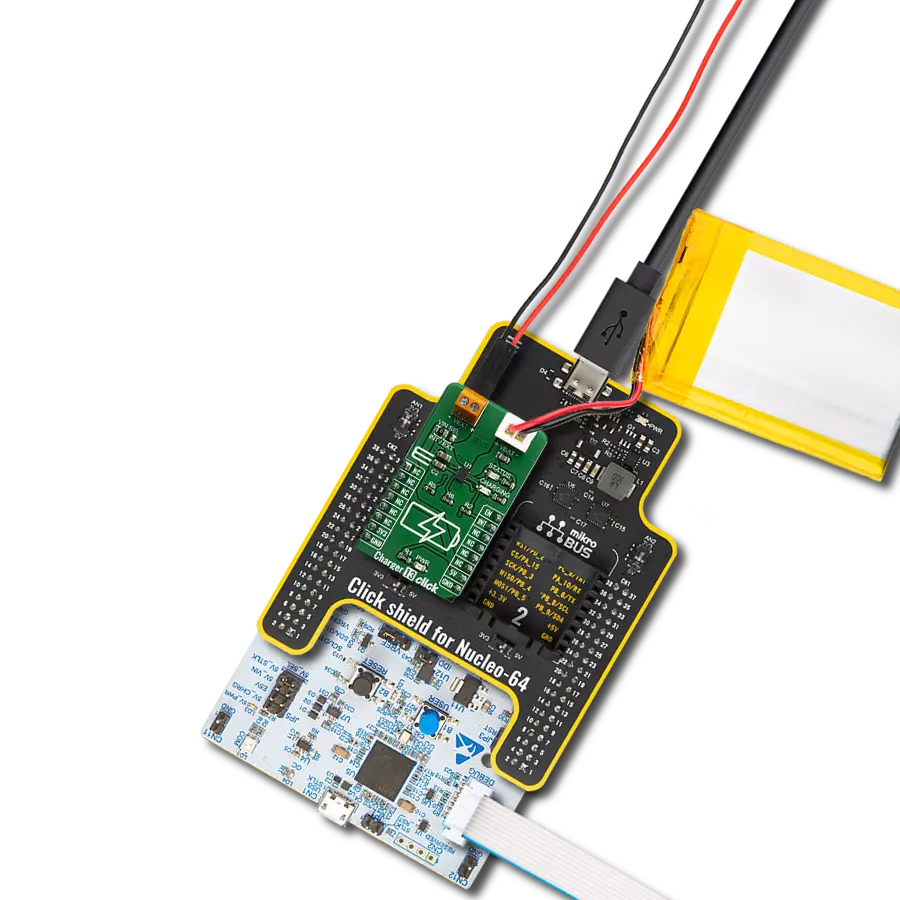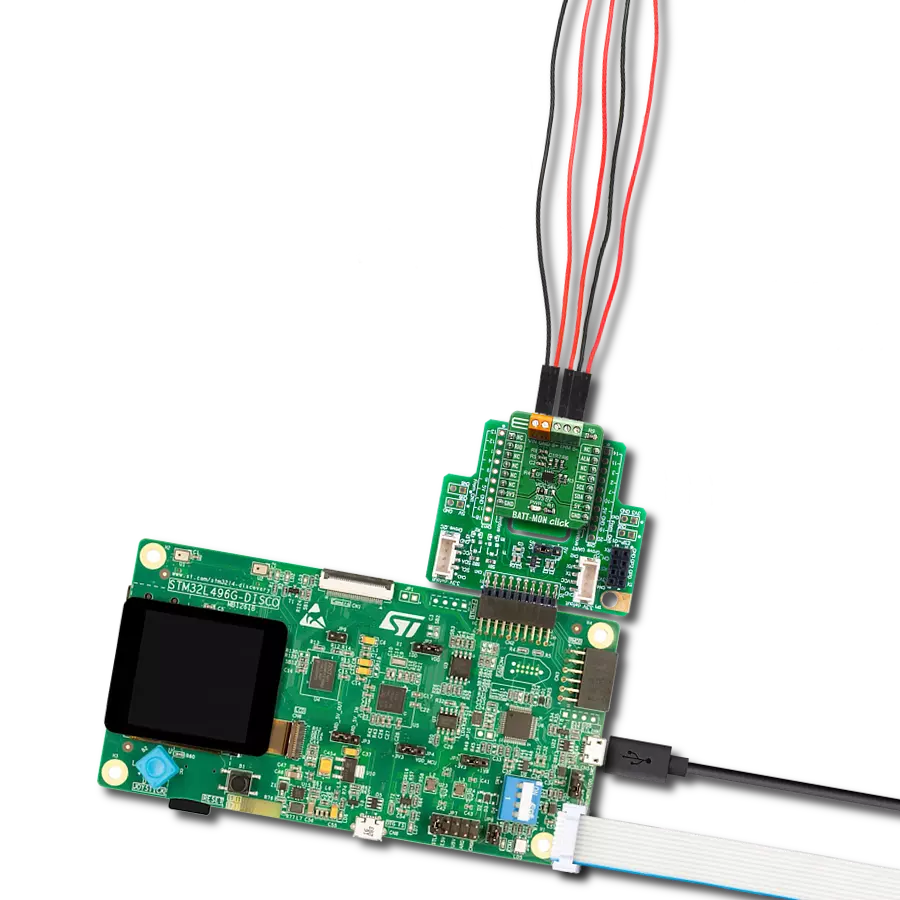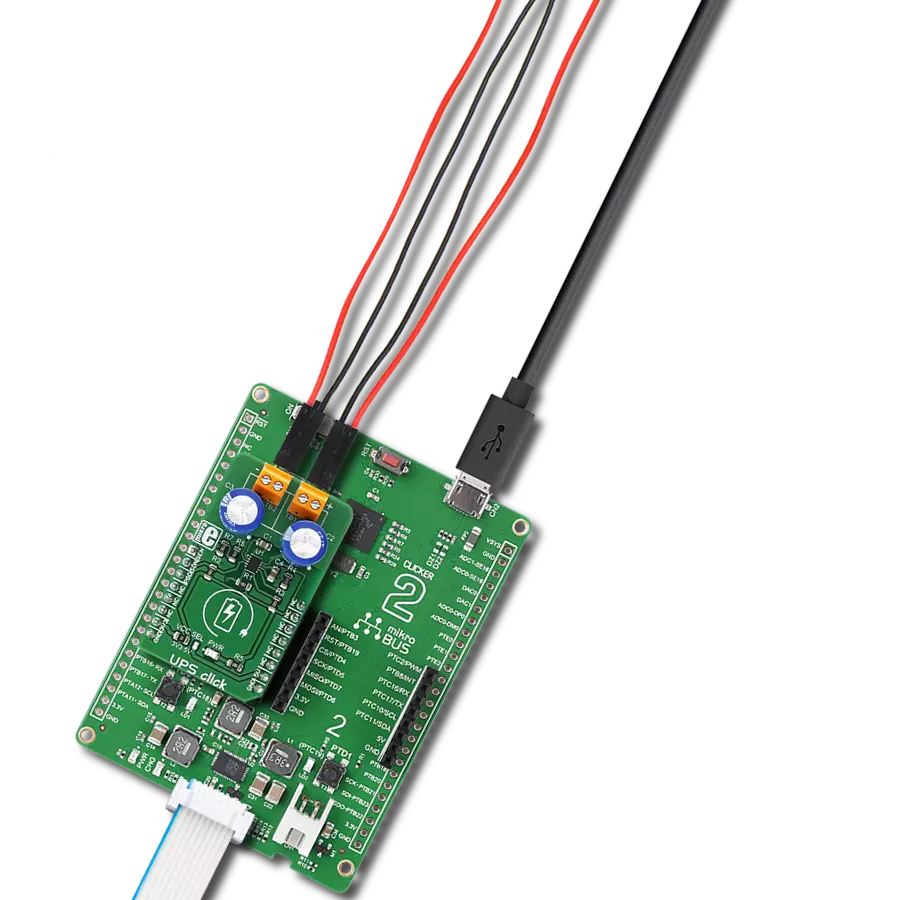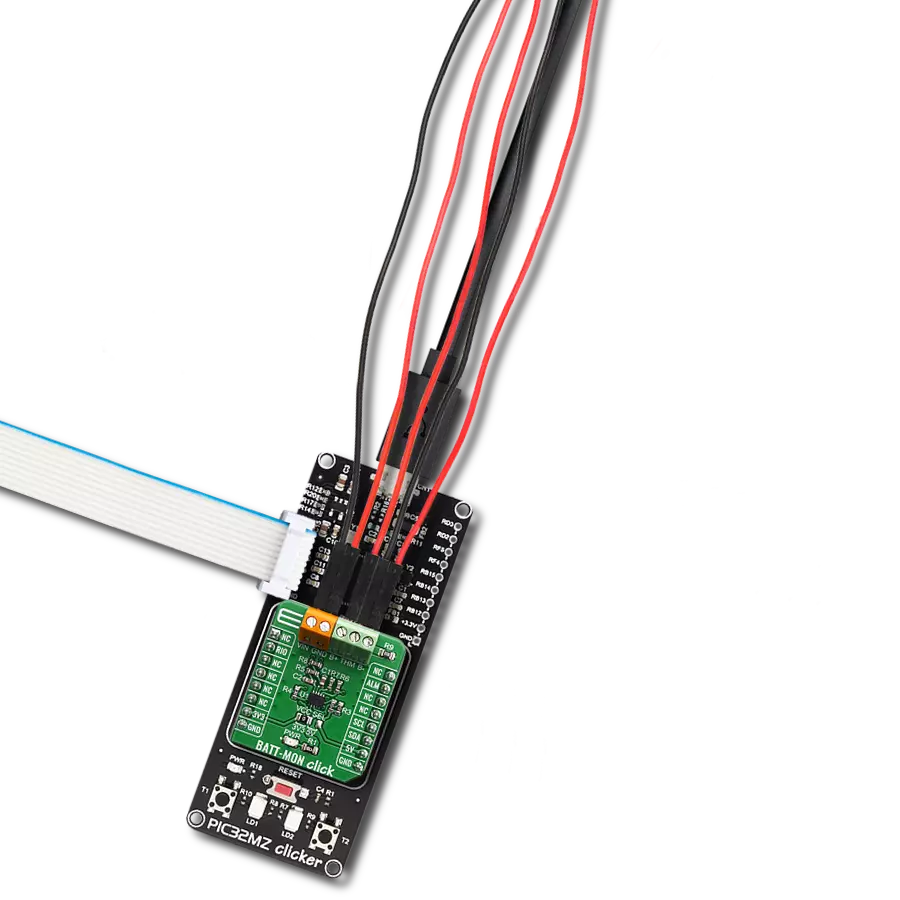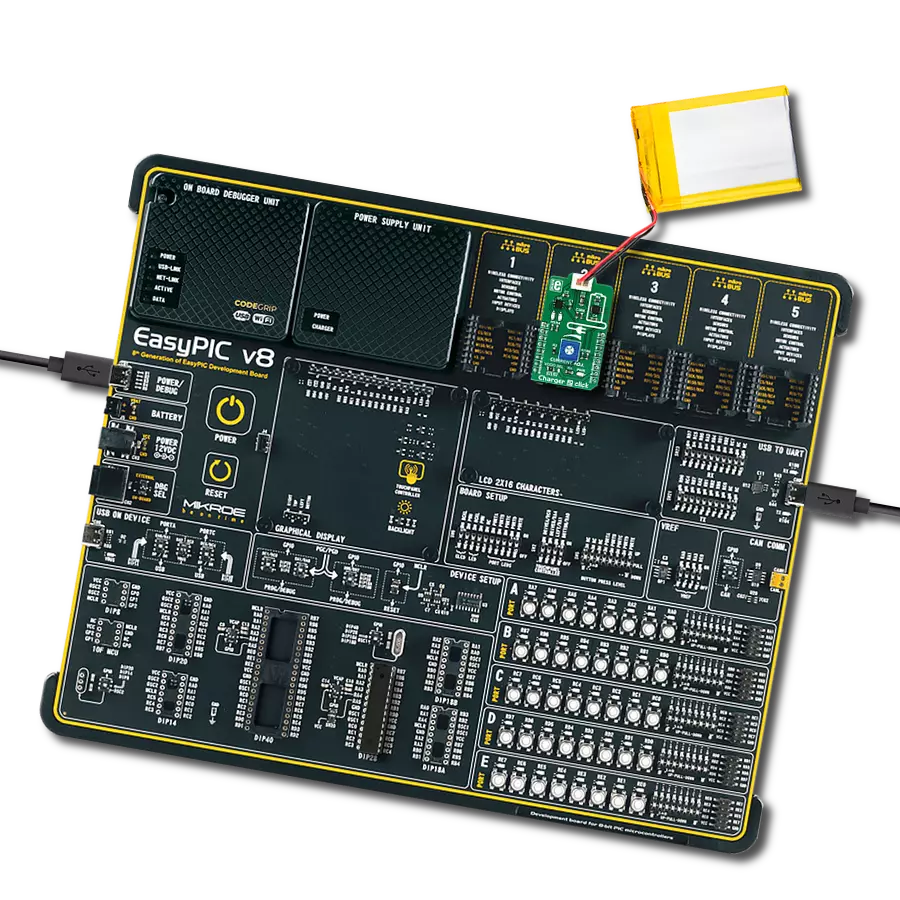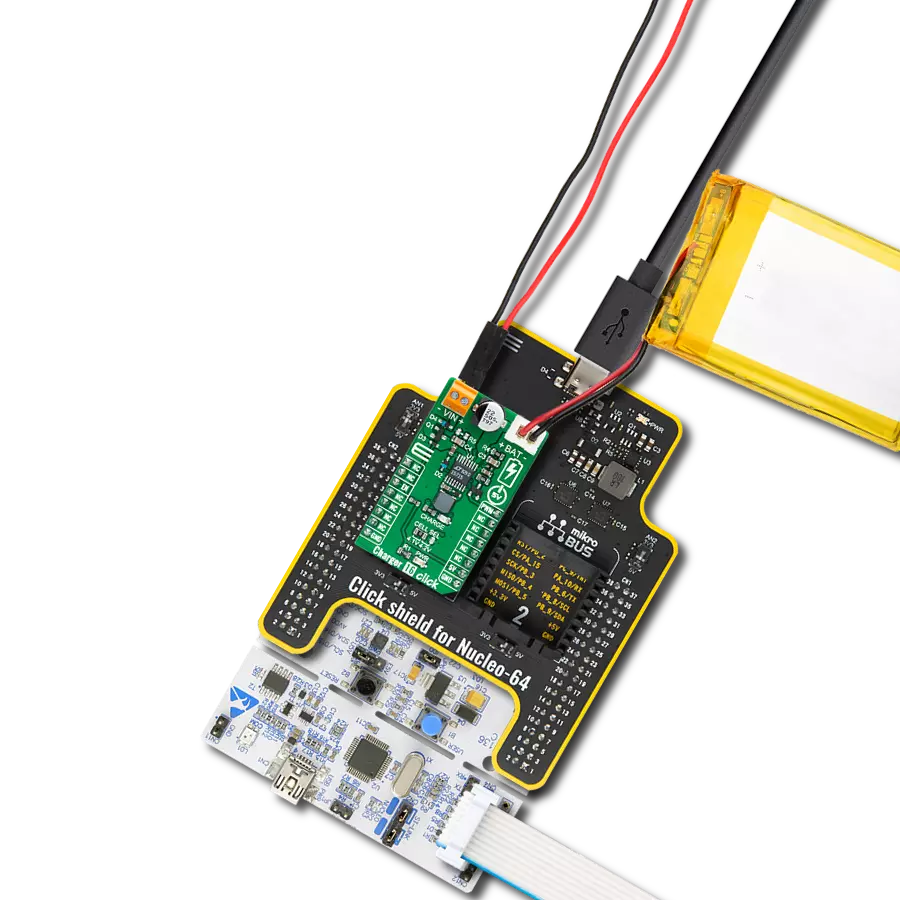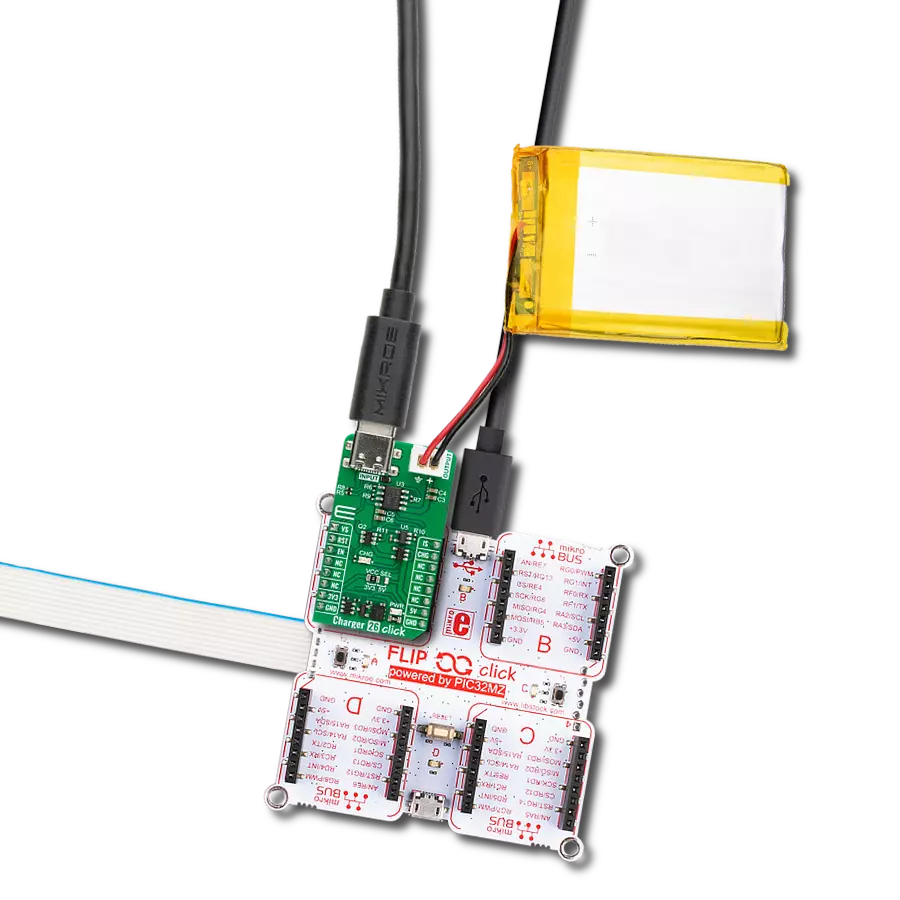Don't let a dead battery catch you off guard - choose innovative fuel gauge and battery diagnostics technology to track battery health and ensure optimal performance
A
A
Hardware Overview
How does it work?
BATT-MON 3 Click is based on the BQ35100, battery fuel gauge, and end-of-service monitor from Texas Instruments that provide gas gauging for lithium thionyl chloride (Li-SOCl2) and lithium manganese dioxide (Li-MnO2) primary batteries without requiring any forced discharge of the battery. The primary lithium gas gauging function uses voltage, current, and temperature data to provide accurate results alongside an ultra-low average power consumption. It also uses patented TI gauging algorithms to support the option of seamlessly replacing an old battery with a new one. This device measures the BT input using the integrated delta-sigma ADC, scaled by the internal translation network, through the ADC. A calibration process determines the translation gain function. It can also operate in three distinct modes: accumulator (ACC), state-of-health (SOH), and end-of-service (EOS)
mode. The device can be configured and used for only one of these modes in the field, as it is not intended to be able to switch between modes when in regular use. BATT-MON 3 Click communicates with MCU using the standard I2C 2-Wire interface to read data and configure settings with a maximum frequency of 400kHz. The BQ35100 is intended for systems with battery electronics that consume a low average current. This board is designed to be fully powered OFF when not required by controlling the enable pin routed to the PWM pin of the mikroBUS™ socket. When this pin is low, the Click board™ is fully powered down with no measurements being made, and no data is retained unless in a flash. An alarm and interrupt function is also available that outputs an interrupt signal to the ALR pin of the mikroBUS™ socket based on various configurable status and data options.
This feature is also indicated by a red LED marked as ALR. Besides, this Click board™ also features battery pack temperature sensing through an integrated temperature sensor or an external NTC thermistor connected to the onboard header labeled as NTC, using the integrated delta-sigma ADC where only one source can be used at a time. This Click board™ can operate with either 3.3V or 5V logic voltage levels selected via the VCC SEL jumper. This way, both 3.3V and 5V capable MCUs can use the communication lines properly. However, the Click board™ comes equipped with a library containing easy-to-use functions and an example code that can be used, as a reference, for further development.

Features overview
Development board
Arduino UNO is a versatile microcontroller board built around the ATmega328P chip. It offers extensive connectivity options for various projects, featuring 14 digital input/output pins, six of which are PWM-capable, along with six analog inputs. Its core components include a 16MHz ceramic resonator, a USB connection, a power jack, an
ICSP header, and a reset button, providing everything necessary to power and program the board. The Uno is ready to go, whether connected to a computer via USB or powered by an AC-to-DC adapter or battery. As the first USB Arduino board, it serves as the benchmark for the Arduino platform, with "Uno" symbolizing its status as the
first in a series. This name choice, meaning "one" in Italian, commemorates the launch of Arduino Software (IDE) 1.0. Initially introduced alongside version 1.0 of the Arduino Software (IDE), the Uno has since become the foundational model for subsequent Arduino releases, embodying the platform's evolution.
Microcontroller Overview
MCU Card / MCU
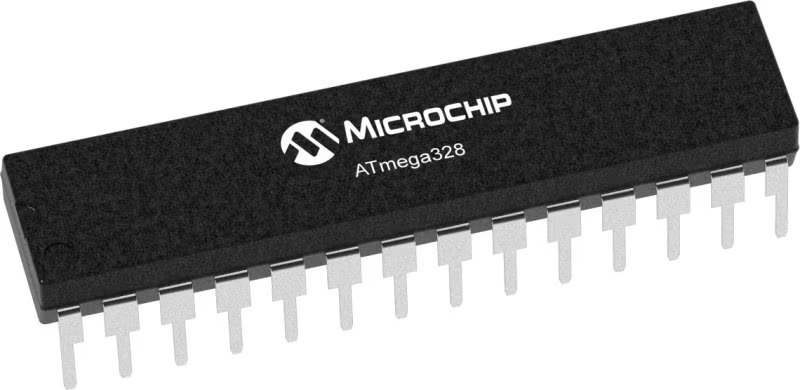
Architecture
AVR
MCU Memory (KB)
32
Silicon Vendor
Microchip
Pin count
32
RAM (Bytes)
2048
You complete me!
Accessories
Click Shield for Arduino UNO has two proprietary mikroBUS™ sockets, allowing all the Click board™ devices to be interfaced with the Arduino UNO board without effort. The Arduino Uno, a microcontroller board based on the ATmega328P, provides an affordable and flexible way for users to try out new concepts and build prototypes with the ATmega328P microcontroller from various combinations of performance, power consumption, and features. The Arduino Uno has 14 digital input/output pins (of which six can be used as PWM outputs), six analog inputs, a 16 MHz ceramic resonator (CSTCE16M0V53-R0), a USB connection, a power jack, an ICSP header, and reset button. Most of the ATmega328P microcontroller pins are brought to the IO pins on the left and right edge of the board, which are then connected to two existing mikroBUS™ sockets. This Click Shield also has several switches that perform functions such as selecting the logic levels of analog signals on mikroBUS™ sockets and selecting logic voltage levels of the mikroBUS™ sockets themselves. Besides, the user is offered the possibility of using any Click board™ with the help of existing bidirectional level-shifting voltage translators, regardless of whether the Click board™ operates at a 3.3V or 5V logic voltage level. Once you connect the Arduino UNO board with our Click Shield for Arduino UNO, you can access hundreds of Click boards™, working with 3.3V or 5V logic voltage levels.
Li-Polymer Battery is the ideal solution for devices that demand a dependable and long-lasting power supply while emphasizing mobility. Its compatibility with mikromedia boards ensures easy integration without additional modifications. With a voltage output of 3.7V, the battery meets the standard requirements of many electronic devices. Additionally, boasting a capacity of 2000mAh, it can store a substantial amount of energy, providing sustained power for extended periods. This feature minimizes the need for frequent recharging or replacement. Overall, the Li-Polymer Battery is a reliable and autonomous power source, ideally suited for devices requiring a stable and enduring energy solution. You can find a more extensive choice of Li-Polymer batteries in our offer.
Used MCU Pins
mikroBUS™ mapper
Take a closer look
Click board™ Schematic

Step by step
Project assembly
Software Support
Library Description
This library contains API for BATT-MON 3 Click driver.
Key functions:
battmon3_read_voltageThis function reads the battery voltage in millivolts.battmon3_read_currentThis function reads the battery current load from BATT+ to GND in milliamps.battmon3_read_used_capacityThis function reads the used battery capacity in mAh.
Open Source
Code example
The complete application code and a ready-to-use project are available through the NECTO Studio Package Manager for direct installation in the NECTO Studio. The application code can also be found on the MIKROE GitHub account.
/*!
* @file main.c
* @brief BATTMON3 Click example
*
* # Description
* This example demonstrates the use of BATT-MON 3 Click by measuring the battery
* voltage, current and used capacity, as well as the chip internal temperature.
*
* The demo application is composed of two sections :
*
* ## Application Init
* Initialized the driver and performs the Click default configuration.
*
* ## Application Task
* Reads the battery voltage (mV), current (mA), used capacity (mAh) and the chip internal
* temperature (Celsius) and displays the results on the USB UART approximately once per second.
*
* @author Stefan Filipovic
*
*/
#include "board.h"
#include "log.h"
#include "battmon3.h"
static battmon3_t battmon3;
static log_t logger;
void application_init ( void )
{
log_cfg_t log_cfg; /**< Logger config object. */
battmon3_cfg_t battmon3_cfg; /**< Click config object. */
/**
* Logger initialization.
* Default baud rate: 115200
* Default log level: LOG_LEVEL_DEBUG
* @note If USB_UART_RX and USB_UART_TX
* are defined as HAL_PIN_NC, you will
* need to define them manually for log to work.
* See @b LOG_MAP_USB_UART macro definition for detailed explanation.
*/
LOG_MAP_USB_UART( log_cfg );
log_init( &logger, &log_cfg );
log_info( &logger, " Application Init " );
// Click initialization.
battmon3_cfg_setup( &battmon3_cfg );
BATTMON3_MAP_MIKROBUS( battmon3_cfg, MIKROBUS_1 );
if ( I2C_MASTER_ERROR == battmon3_init( &battmon3, &battmon3_cfg ) )
{
log_error( &logger, " Communication init." );
for ( ; ; );
}
if ( BATTMON3_ERROR == battmon3_default_cfg ( &battmon3 ) )
{
log_error( &logger, " Default configuration." );
for ( ; ; );
}
log_info( &logger, " Application Task " );
}
void application_task ( void )
{
uint16_t voltage;
int16_t current;
float temperature, used_capacity;
if ( BATTMON3_OK == battmon3_read_voltage ( &battmon3, &voltage ) )
{
log_printf ( &logger, " Voltage: %u mV\r\n", voltage );
}
if ( BATTMON3_OK == battmon3_read_current ( &battmon3, ¤t ) )
{
log_printf ( &logger, " Current: %d mA\r\n", current );
}
if ( BATTMON3_OK == battmon3_read_temperature ( &battmon3, &temperature ) )
{
log_printf ( &logger, " Temperature: %.3f C\r\n", temperature );
}
if ( BATTMON3_OK == battmon3_read_used_capacity ( &battmon3, &used_capacity ) )
{
log_printf ( &logger, " Used Capacity: %.3f mAh\r\n\n", used_capacity );
}
Delay_ms ( 1000 );
}
int main ( void )
{
/* Do not remove this line or clock might not be set correctly. */
#ifdef PREINIT_SUPPORTED
preinit();
#endif
application_init( );
for ( ; ; )
{
application_task( );
}
return 0;
}
// ------------------------------------------------------------------------ END
Additional Support
Resources
Category:Battery charger




















